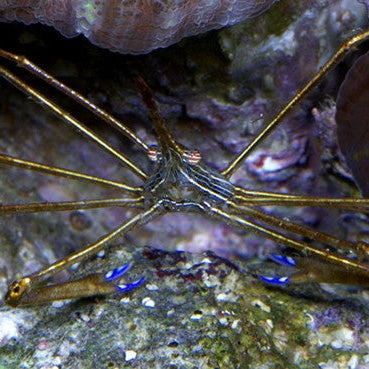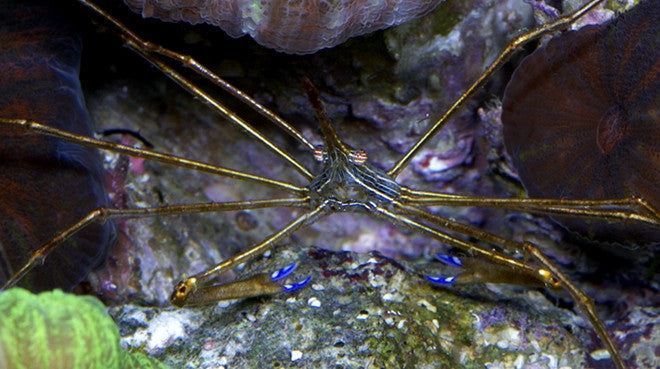Black Friday SALE 50% OFF ALL Frags & 25% OFF ALL Colonies
Arrow Crab
$ 24.99 $ 29.99
Please select all options.
How to Care for Arrow Crab
written by Dave Burr
The Arrow Crab uses its very long legs to walk over the reef and to climb over almost any obstacle.
Behavior: It rarely bother corals, however the occasional large specimen may pick at small passive fishes. Some Arrow Crabs will eat troublesome bristle worms. Overall, a great reef inhabitant that can live for several years in the home aquarium.
Growth: Maintaining proper Ca, Alk, & Mg levels is important for growth of their shells.
Feeding: The Arrow Crab is a good scavenger and will eat scraps of meaty food missed by the fish.
Care Level: Easy
Reef Compatible: Yes - semi-aggressive as they mature
Diet: Carnivore
Range: Caribbean, Mexico
Family: Majidae
Water Conditions: 75-80° F; sg 1.024-1.026 (1.025 is ideal); pH 8.1-8.4 Ca 420-440 ppm, Alk 8-9.5 dKH, Mg 1260-1350, Nitrates <10ppm, Phosphates < .10ppm
Water Chemistry: It is important that proper calcium (420-440 ppm), alkalinity (8-9.5 dkh - run it 7-8 if you are carbon dosing) , and magnesium levels (1260-1350 ppm) are maintained. Raising magnesium levels gradually up to 1400-1600 ppm can help to combat algae outbreaks, just keep CA and Alk in line as you raise the Mg. Nitrates should be below 10 ppm and phosphates should be below .10 ppm. We recommend doing a water change when Nitrate levels rise to 10 ppm. It is important to replace your phosphate media when phosphates rise to .10 ppm. Media Reactors make the most efficient use of your phosphate media by fluidizing it.
Dosing: Vivid Aquariums uses and recommends dosing pumps to automate the dosing of additives and keep your levels more constant. A dosing pump can alleviate the chore of manually dosing your aquarium with Ca, Alk, & Mg 2,3, or 4 times per week and will benefit your aquarium by keeping your levels constant through frequent small additions of Ca, Alk, & Mg. Our tanks all progressed when we switched from 3 manual dosings per week to 70 automatic dosings per week and we got a lot more work done.
Category: 10-25, carnivore, Clean Up Crew, Crabs, easy, live coral & inverts, stenorhynchus-seticornis
Type: Invert



